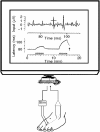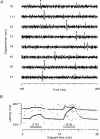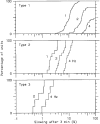Activity-dependent slowing of conduction differentiates functional subtypes of C fibres innervating human skin
- PMID: 10066906
- PMCID: PMC2269177
- DOI: 10.1111/j.1469-7793.1999.799ab.x
Activity-dependent slowing of conduction differentiates functional subtypes of C fibres innervating human skin
Abstract
1. The effects of impulse activity on conduction in cutaneous C fibres have been examined in 46 microneurographic recordings from 11 normal subjects and 11 diabetic patients with normal nerve conduction. A tungsten microelectrode was inserted into a cutaneous nerve, usually the superficial peroneal close to the ankle, and intraneural microstimulation was used to identify an area of skin innervated. Three minute trains of 0.25 ms stimuli at 1, 2 and 4 Hz were then delivered to the surface of the skin, separated by intervals of 6 min with stimulation at 0.25 Hz. Slowing and block of conduction were measured from the nerve responses for up to seven C units per stimulation sequence. 2. Three types of C unit were distinguished by their responses to repetitive stimulation: type 1 units slowed progressively during the 3 min trains; slowing of type 2 units reached a plateau within 1 min; while type 3 units hardly slowed at all. Data from normal and diabetic subjects did not differ and were pooled. After 3 min at 2 Hz, the percentage increases in latency were for type 1, 28.3 +/- 9.7 (n = 63 units, mean +/- s.d.); for type 2, 5.2 +/- 1.6 (n = 14); and for type 3, 0.8 +/- 0.5 (n = 5), with no overlap. After 3 min at 4 Hz, 58 % of type 1 units (but no type 2 or 3 units) blocked intermittently. Recovery of latency after stimulation was faster for type 2 than for type 1 units, but conduction velocities of the three types were similar. 3. Type 1 units were identified as nociceptors and 7 type 2 units were identified as 'cold' fibres, activated by non-noxious cold, with no overlap in modality. None of the units tested was activated by weak mechanical stimuli or reflex sympathetic activation. 4. Spike waveforms were averaged for 18 type 1, 10 type 2 and 6 type 3 units. All units had predominantly triphasic action potentials with a major negative peak, but those of type 3 units were on average both smaller and briefer than those of type 1 and type 2 units. 5. It is concluded that repetitive electrical stimulation reliably differentiates nociceptive from cold-specific C fibres innervating human hairy skin, as has previously been shown for the rat. Cold fibres can propagate impulses continuously at much higher rates than nociceptive fibres. The nature of the type 3 units is unclear.
Figures














Comment in
-
Surprising diversity in axonal properties between the different functional classes of neurone in peripheral nerves.J Physiol. 1999 Mar 15;515 ( Pt 3)(Pt 3):629. doi: 10.1111/j.1469-7793.1999.629ab.x. J Physiol. 1999. PMID: 10066892 Free PMC article. No abstract available.
Similar articles
-
Partial reversal of conduction slowing during repetitive stimulation of single sympathetic efferents in human skin.Acta Physiol Scand. 2004 Nov;182(3):305-11. doi: 10.1111/j.1365-201X.2004.01357.x. Acta Physiol Scand. 2004. PMID: 15491409
-
Activity-dependent slowing of conduction velocity provides a method for identifying different functional classes of C-fibre in the rat saphenous nerve.Neuroscience. 1996 Aug;73(3):667-75. doi: 10.1016/0306-4522(96)00070-x. Neuroscience. 1996. PMID: 8809788
-
Velocity recovery cycles of C fibres innervating human skin.J Physiol. 2003 Dec 1;553(Pt 2):649-63. doi: 10.1113/jphysiol.2003.046342. Epub 2003 Sep 8. J Physiol. 2003. PMID: 12963801 Free PMC article.
-
Velocity recovery cycles of single C fibres innervating rat skin.J Physiol. 2007 Jan 1;578(Pt 1):213-32. doi: 10.1113/jphysiol.2006.116129. Epub 2006 Oct 5. J Physiol. 2007. PMID: 17023508 Free PMC article.
-
Evidence for direct neural regulation of the mammalian anterior pituitary.Clin Exp Pharmacol Physiol. 1999 Oct;26(10):757-9. doi: 10.1046/j.1440-1681.1999.03128.x. Clin Exp Pharmacol Physiol. 1999. PMID: 10549397 Review.
Cited by
-
Impulse propagation over tactile and kinaesthetic sensory axons to central target neurones of the cuneate nucleus in cat.J Physiol. 2003 Jul 15;550(Pt 2):553-62. doi: 10.1113/jphysiol.2002.037002. Epub 2003 May 23. J Physiol. 2003. PMID: 12766249 Free PMC article.
-
Microneurographic assessment of C-fibre function in aged healthy subjects.J Physiol. 2009 Jan 15;587(2):419-28. doi: 10.1113/jphysiol.2008.162941. Epub 2008 Dec 8. J Physiol. 2009. PMID: 19064617 Free PMC article.
-
A search for activation of C nociceptors by sympathetic fibers in complex regional pain syndrome.Clin Neurophysiol. 2010 Jul;121(7):1072-9. doi: 10.1016/j.clinph.2009.12.038. Epub 2010 Mar 31. Clin Neurophysiol. 2010. PMID: 20359942 Free PMC article.
-
Sodium channel slow inactivation and adaptation in C-fibres.J Physiol. 2012 Apr 1;590(7):1513-4. doi: 10.1113/jphysiol.2011.224436. J Physiol. 2012. PMID: 22467918 Free PMC article. No abstract available.
-
Repetitive activity slows axonal conduction velocity and concomitantly increases mechanical activation threshold in single axons of the rat cranial dura.J Physiol. 2012 Feb 15;590(4):725-36. doi: 10.1113/jphysiol.2011.220624. Epub 2011 Dec 5. J Physiol. 2012. PMID: 22144575 Free PMC article.
References
-
- Bergmans J. The Physiology of Single Human Nerve Fibres. Vander, Belgium: University of Louvain; 1970.
-
- Bostock H, Cikurel K, Burke D. Threshold tracking techniques in the study of human peripheral nerve. Muscle and Nerve. 1998;21:137–158. - PubMed
-
- Davis KD, Meyer RA, Campbell JN. Chemosensitivity and sensitization of nociceptive afferents that innervate the hairy skin of monkey. Journal of Neurophysiology. 1993;69:1071–1081. - PubMed
Publication types
MeSH terms
Grants and funding
LinkOut - more resources
Full Text Sources
Other Literature Sources
Medical

